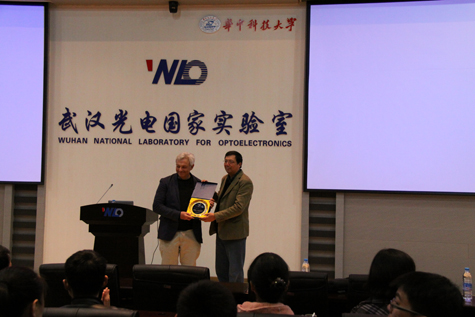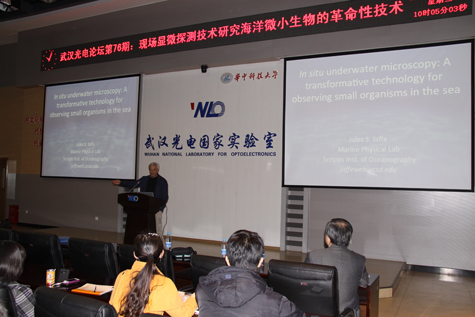WUHAN, China (November 13, 2013) - Wuhan Optoelectronics Forum No. 76 was successfully held in Auditorium A101 at Wuhan National Laboratory for Optoelectronics (WNLO) in the morning of November 13.
In this talk, Dr. Jaffe will describe both the technical advances and resulting science that his group has achieved over the last decades in characterizing oceanic biota with in situ optical imaging systems. One effort, underway for several decades, concerns the use of planar laser illumination in order to observe fluorescent particle distributions. Deployed from an autonomous, free-descent vehicle, the system detected "cryptic peaks" or fluorescent layers of particles, that were not seen in the bulk chlorophyll fluorescence profiles. Such layers, likely food for the larger zooplankton herbivores, are important features of pelagic ecosystems. More recently, Dr. Jaffes lab has developed a spectrum of underwater imaging microscopes that take pictures of organisms through ports, thus permitting identification of various macro, and micro plankton in relatively undisturbed waters. Results of the analysis of such data, currently underway, will be described.
Jules Jaffe is a research oceanographer with the Marine Physical Laboratory at Scripps Institution of Oceanography, University of California, San Diego. His research interests are broadly concerned with the use of new technology for observing oceanic phenomena and the development of inverse techniques for their interpretation. His research has focused primarily on ocean ecology; he has also worked in biomedical applications. In the realm of ocean ecology, several acoustic systems invented by Jaffe resulted in the first-ever behavioral observations of zooplankton in situ. In addition, the small-scale distribution of phytoplankton, as mapped via an autonomously deployed imaging fluorometer has provided unprecedented views of oceanic biota. Current projects under way in his lab concern the use of diffraction tomography in order to characterize microbes using optics and to characterize animals (including shape and size) using acoustics. A new generation of miniature, sensor-equipped drifters that can acoustically network is also being considered in order to gain insights into coastal circulation and larval transport. The National Science Foundation, the Office of Naval Research, California Sea Grant, The ARMY foundation for breast cancer research, The SeaverInstitute and the Keck Foundation have supported his work.

